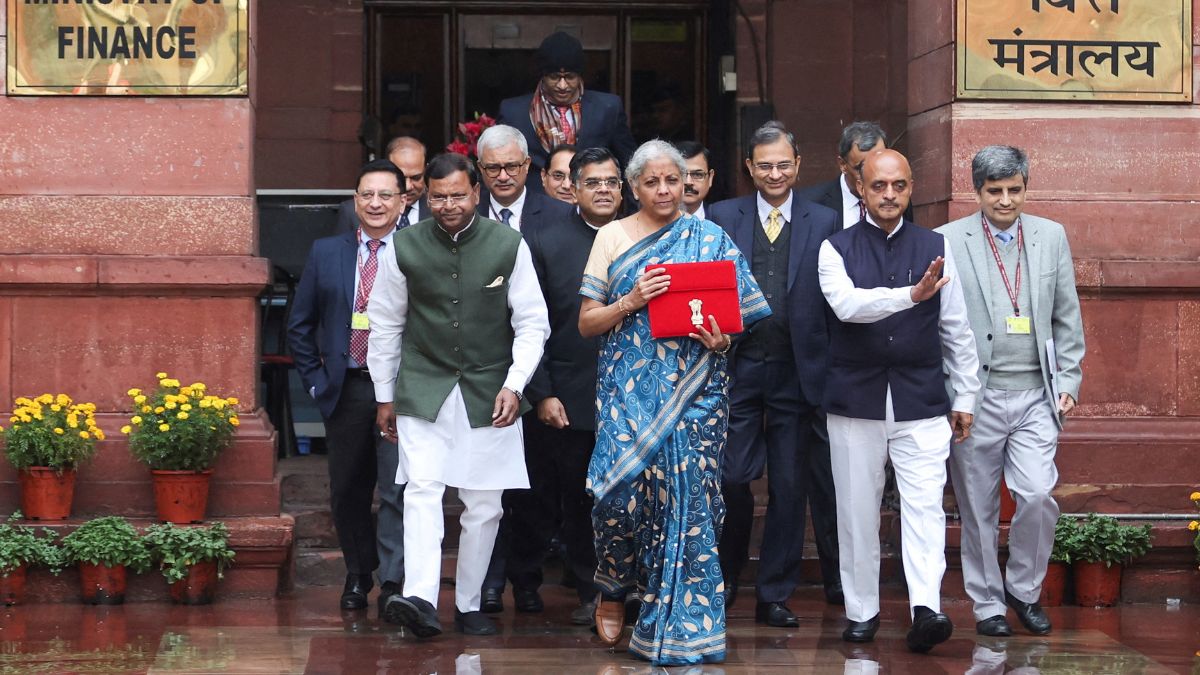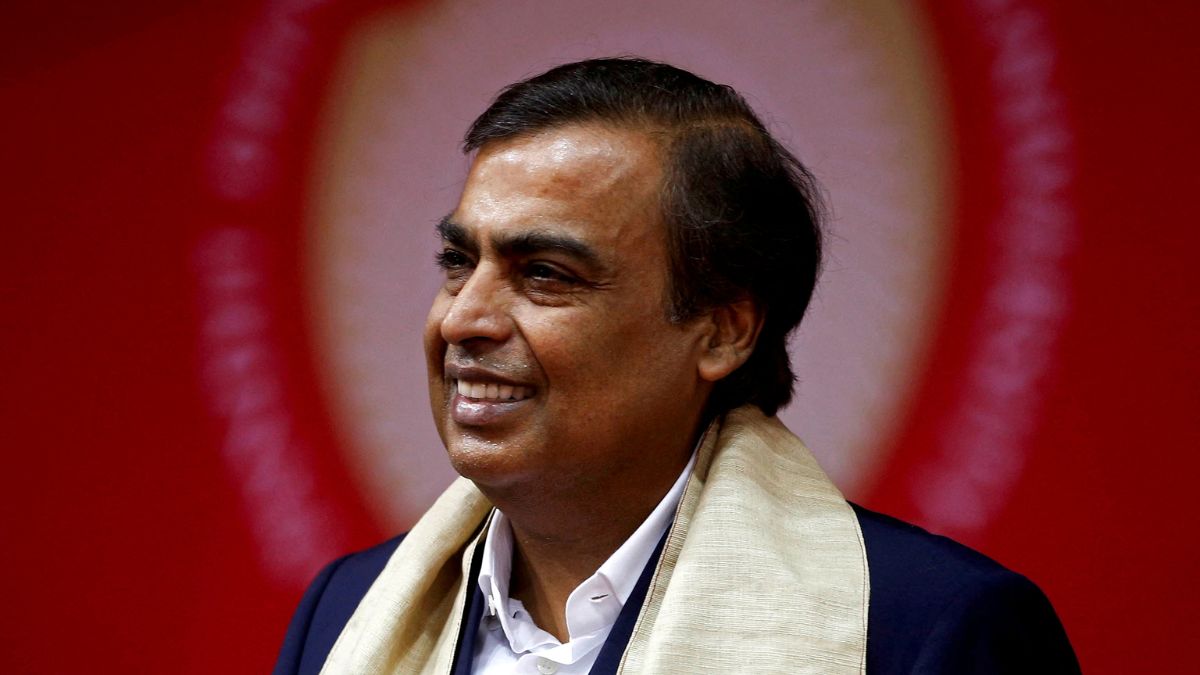The Economic Survey for the year 2023-24 was tabled in Parliament on Monday setting the tone for the presentation of the Union Budget on July 23 by Finance Minister Nirmala Sitharaman. Having established India as the fastest-growing economy in the world, the survey comes at a crucial time when global economies are struggling with inflation and recession woes read more
)
Finance Minister Nirmala Sitharaman holds up a folder with the Government of India's logo as she leaves her office to present the interim federal budget in parliament, in New Delhi, India, February 1, 2024. File Image/Reuters
Union Finance Minister Nirmala Sitharaman tabled the Economic Survey 2023-24 on Monday (July 22) in Parliament, presenting a comprehensive analysis of India’s economic trajectory amid global challenges.
The survey, which projects a real GDP growth of 6.5 to 7 per cent for the current fiscal year, offers an in-depth examination of various sectors and their performance, providing crucial insights into the state of the economy. This document is pivotal for understanding the economic trends, policy challenges, and potential growth areas for India.
What is the economic survey
The Economic Survey is a detailed annual document prepared by the Economic Division of the Department of Economic Affairs in the Ministry of Finance. It is formulated under the supervision of the Chief Economic Advisor (V Anantha Nageswaran is the current CEA of India) and provides a statistical and analytical overview of the economy.
The survey covers a range of topics, including GDP growth, inflation, employment, sectoral performance, and budget deficits. Its primary purpose is to inform policymakers, businesses, and the public about the economic conditions and the challenges ahead.
The first Economic Survey was introduced in 1950-51 and was initially part of the budget documents. In the 1960s, it was separated from the budget and presented a day before the Union Budget. Over the years, the survey has evolved to include various themes that reflect the country’s economic priorities.
LIVE: Firstpost’s coverage of the Economic Survey 2023-24 & Union Budget 2024
For instance, the 2022 survey focused on the ‘Agile Approach,’ highlighting India’s economic response to the COVID-19 pandemic, while the 2023 survey played up the theme of ‘recovery complete,’ indicating a broad-based recovery from the pandemic, geopolitical conflicts, and inflation. The first chapter of the the 2023-24 survey, highlighting the state of the economy is titled - ‘Steady as she goes’.
Why the Economic Survey matters
The economic survey provides observations and details provide an official framework for analysing the Indian economy and offer policy recommendations, even though they are not binding on the Budget. The survey’s insights help shape public discourse and inform economic policies.
Sitharaman’s upcoming budget presentation marks her seventh. Her budget speeches have been pivotal in shaping India’s economic policies, and the Economic Survey provides a crucial framework for these announcements.
The survey’s significance lies in its detailed analysis of the economy and its role in guiding policymakers and stakeholders in making informed decisions.
Key Takeaways of the 2023-24 Economic Survey:
Inflation a critical focus
The Economic Survey 2023-24 projects a real GDP growth rate between 6.5 and 7 per cent, slightly lower than the 8.2 per cent growth estimated for the previous financial year. This conservative projection takes into account global economic uncertainties that may impact exports.
The Reserve Bank of India (RBI) has forecasted the GDP growth for FY25 at 7.2 per cent. Global agencies like the International Monetary Fund (IMF) and the Asian Development Bank (ADB) also project India’s growth at 7 per cent.
The survey indicates that domestic growth drivers have played a significant role in supporting economic growth in 2023-24, despite uncertain global economic conditions. Improved balance sheets in the private sector are expected to cater to strong investment demand.
Also Read | ‘Let go some of your power and enjoy the lightness’: Economic Survey 2023-24 advises government
However, the survey adds a note of caution, stating, “private capital formation after good growth in the last three years may turn slightly more cautious because of fears of cheaper imports from countries that have excess capacity.”
Inflation remains a critical focus of the survey. While the overall headline inflation rate is largely under control, specific food items have seen elevated prices. The survey projects the inflation rate to be 4.5 per cent in FY25 and 4.1 per cent in FY26.
The expectation of a normal monsoon and moderating global prices of key imported items support these projections. The survey notes that “prudent administrative measures” have helped India keep inflation in check compared to the rest of the world in the post-COVID recovery phase.
Can agriculture lead the way?
Agriculture has been a significant focus of the government, with the promise of doubling farm incomes to revive the rural economy. The Economic Survey highlights the critical role of agriculture in India’s growth, stating the need for a pan-India dialogue to address sectoral challenges. The survey describes agriculture as “one area ripe for and in need of such a pan-India dialogue.”
The government provides substantial support to farmers through subsidies for water, electricity, and fertilizers, along with a minimum support price (MSP) for 23 selected commodities. Monthly cash support is offered through the PM-KISAN scheme, and loan write-offs are common.
Despite these efforts, the survey suggests that smallholder farmers need to shift from traditional crops like rice, wheat, and millets to high-value agriculture, including fruits, vegetables, fisheries, poultry, dairy, and buffalo meat.
Also Read | Union Budget: How to bridge financial knowledge divide in tier-2 and tier-3 cities
This shift is seen as essential for increasing farmers’ incomes and spurring a manufacturing revolution, similar to what China experienced between 1978 and 1984 when the real incomes of farmers doubled in just six years.
The survey also highlights the growing significance of allied sectors such as animal husbandry, dairying, and fisheries in enhancing farmers’ incomes. It suggests that greater emphasis should be placed on tapping into the potential of these activities to boost farmers’ incomes.
The performance of the agriculture sector has been growing at an average rate of 4.18 per cent over the last five years, underscoring its importance for the economy’s overall growth.
Role of private sector under spotlight
The Economic Survey places significant emphasis on the role of the private sector in driving economic growth and job creation. The survey advocates for a tripartite compact involving the central government, state governments, and the private sector to achieve the higher aspirations of Indians and complete the journey to a developed India by 2047.
“Job creation happens mainly in the private sector. Many issues influencing economic growth, job creation, and productivity are in the domain of state governments,” the survey states.
Improved balance sheets in the private sector are expected to cater to strong investment demand. However, the survey cautions that private capital formation may turn more cautious due to fears of cheaper imports from countries with excess capacity.
Also Read | Union Budget 2024: How affordable housing can become a reality for middle class
Despite these challenges, the survey remains optimistic about the potential for growth in merchandise and services exports, driven by improving growth prospects in advanced economies.
The survey also addresses the need for the private sector to adopt India’s traditional lifestyle, food, and recipes, which have shown how to live healthily and sustainably. It criticises the contribution of the private sector to unhealthy food consumption habits and sedentary lifestyles, which can undermine public health and productivity.
The survey suggests that embracing traditional practices can help the private sector tap into a global market.
Approval of retail investment in financial markets with a word of caution…
The Economic Survey highlights the significant increase in retail investors in the stock market, calling for careful consideration to avoid overconfidence and speculation. The survey pointed that the financial sector should support the banking sector and fill the capital gap required for the economy’s growth.
It warns against the over-financialisation of the economy, which has historically led to crises in developing countries.
The survey notes that increased retail participation in financial markets is beginning to grow in line with India’s emergence as the world’s fifth-largest economy. It stresses the importance of firms in banking, insurance, and capital markets to keep consumer interests in mind and improve service quality through fair selling, disclosure, transparency, reliability, and responsiveness.
The survey states, “Their internal appraisal and incentive systems must be in alignment with these considerations. It is in their interest and in the interest of the nation that they optimise their commercial goals over the long run.”
The survey also cautions about the risks associated with derivatives trading, which caters to humans’ gambling instincts and can lead to significant losses for retail investors. It calls for raising investor awareness and continuous financial education to warn them about the low or negative expected returns from derivatives trading.
The survey cites the global financial crisis of 2008 and the Asian crisis of 1997-98 as examples of the detrimental effects of financial market innovations running ahead of economic growth.
Lets’s take advantage of the China Plus One strategy
The Economic Survey suggests that India can benefit from the China Plus One strategy by integrating into China’s supply chain or promoting Chinese foreign direct investment (FDI).
“China-plus-one” refers to a supply chain strategy that encourages companies to reduce their dependency on China by diversifying their sources for parts and products to include other countries. This approach aims to mitigate risks associated with relying heavily on a single country for supply chain needs.
The survey notes that focusing on FDI from China seems more promising for boosting India’s exports to the US, similar to how East Asian economies benefited from US trade diversions from China.
Also Read: How can India benefit from China plus one strategy?
“Will China plus one result in a total movement of trading relations away from China? This may not be the case. Take, for example, nations like Mexico, Vietnam, Taiwan and Korea, which were direct beneficiaries of the US’s trade diversion from China. Even while these nations increased their share of exports to the US, they also displayed a concomitant rise in Chinese FDI.”
The survey highlights that as the US and Europe shift their immediate sourcing away from China, it is more effective to have Chinese companies invest in India and then export the products to these markets rather than importing from China, adding minimal value, and re-exporting them.
This strategy would help India reduce its trade deficit with China and boost its exports to advanced economies.
Need for sustainable reforms
The Economic Survey underscores the need for effective implementation of the big-ticket reforms introduced over the last decade. These reforms have focused on restoring the health of the economy, elevating potential growth by relieving supply-side constraints, and strengthening governance capabilities.
The survey stressed that the next stage is to ensure these reforms are fully implemented to deliver sustainable and inclusive growth.
The survey suggests that the government’s focus must shift to bottom-up reform and the strengthening of governance. This involves engaging with state governments, the private sector, and civil society to ensure that the reforms translate into tangible benefits for the economy.
Also Read | From NPS to PM-JAY: Why Budget 2024 may bring good news India’s senior citizens
The survey states, “Big-ticket reforms have been initiated and done. The Government’s focus must turn to bottom-up reform and the strengthening of the plumbing of governance.”
This approach is seen as essential for addressing the challenges of job creation, productivity improvement, and economic growth. The survey calls for a collaborative effort between the central government, state governments, and the private sector to achieve these goals and complete the journey to a developed India by 2047.
The 2023-24 Economic Survey is a crucial tool in shaping economic policies for businesses and stakeholders. This year’s economic outlook is especially important for India as it consolidates its power in the ‘Global South’ as a leader that can compete against established but strained economies in the West.
Anmol is a Senior Sub-Editor with Firstpost. He likes to cover stories that intrigue him, generally revolving around international polity, Indian foreign policy, human interest, environment and even the politically-charged election cycles in India. He has far too many disparate interests with a constant itch for travel. Having visited fourteen states in the Indian subcontinent, he is always on the lookout for opportunities to add more to the list. He enjoys watching Football, Tennis and F1 purely as a sports enthusiast. see more

 1 month ago
17
1 month ago
17
)
)
)
)
)
)
)
)
)
)
)
)
)
)
)
)
)
)
)
)
)
)
)
 English (US) ·
English (US) ·